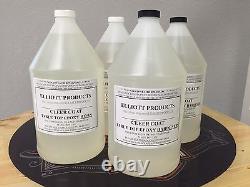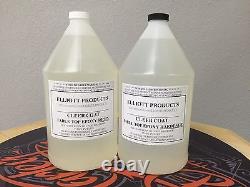6 gallons, CRYSTAL CLEAR, TABLE TOP EPOXY, HIGH GLOSS



CRYSTAL CLEAR TABLE TOP and ART WORK EPOXY KIT. 1/2 Gallon Resin and 1/2 Gallon Hardener. 1 Gallons Resin and 1 Gallon Hardener. 2 Gallons Resin and 2 Gallons Hardener. 3 Gallons Resin and 3 Gallons Hardener.
8 Gallons Resin and 8 Gallons Hardener. 12 Gallons Resin and 12 Gallons Hardener. This product is a 100% solid, two component, clear polymer coating that is mixed at a 1 to 1 ratio by volume.
Each kit contains a bottle of resin and a bottle of hardener. Max size of containers are 1 gallon for easy use.
The product cures to a clear, high build, glass like finish that resists scratching, yellowing and will not distort with age. Items coated with it will become permanently preserved and protected for your enjoyment throughout a lifetime. This product will not exhibit blushing or sweat out under high humidity conditions. This product is commonly seen on bar tops and table tops in many bars and restaurants.Recently I have had several buyers use this material for making river tables and in art works with very good success. The product should be applied in two stages to clean surfaces.
The first stage is referred to as the seal coat. The seal coat is brushed on in a thin layer and is used to seal any pores in the surface and prevent air bubbles from forming in the following flood coats. This stage is followed by the flood coat, which will flow and self level, clean brushes or squeegees can be used to help spread the epoxy. Flood coats are applied in 1/8 layers at a time, as many as desired can be applied, however one to three coats is average for most table or bar coatings. Note: See recoating between layers below.
Recoating can usually be be done within 4 to 8 hours. If re-coated within this time period no sanding is necessary between layers. If your previous layer has fully dried, light sanding with 220 or 320 grit sandpaper is recommended to achieve good bonding surface. After sanding you should wipe down with a solvent such as denatured alcohol, acetone or lacquer thinner to remove any impurities from the surface. Note: These solvents are flammable and should be use in a ventilated area. (do NOT use mineral spirits). Objects, such as pictures, maps etc. Can be imbedded in this product during the pours.Most photo quality paper does not require any special preparation however sometimes thin paper objects must first be sealed with a white glue or similar product to prevent the cleer coat from fully penetrating the paper and causing it to become transparent. Imbeding Solid Objects wood, rocks, shells, etc.
All porous materials should first have a seal coat of epoxy applied. This will prevent air bubbles from occurring in subsequent flood coats. Usually the objects can be setin place before sealing. Note: Do not add more than 1/8 at each pour. For best results the product should be used at temperatures from 70-80 degrees F. The room which you are working should be clean, dry, dust and insect free. Settling dust can often cause blemishes on the glassy surface. Please note that although this product will resist yellowing better than other epoxies it is NOT 100% UV resistant. Continuous outdoor UV exposure over months or years will cause the finish to lose its gloss and cause gradual changes in color. See the coverage charts shown below to calculate the amount you will need for your area.Remember not to combine seal and flood coat coverage's. Flood coats are designed to go on approximately 1/8 thick, which is about three times thicker than that of a seal coat. Example: A 6ft x 4ft bare wood table (24 sqft) would require 2 Quarts to complete ONE seal coat and about a gallon and a half to complete ONE flood coat for a total of Two Gallons. This material leaves professional results when applied correctly so take your time and make sure to beware of these common problems we have seen encountered by first time users.
Be sure to level you project, because this material is self leveling. It might be a good idea to try this material on a piece of scrap before using on a your project. Always make sure that your mixing container is clean and your measuring device is accurate, this product REQUIRES that you mix at a 1 to 1 ratio by volume, any variances from this can cause the epoxy to stay soft and not fully cure. This product requires a THOROUGH mixing, usually between 3-4 minutes of solid mixing without excessive whipping of the mixture(whipping will put lots of air bubbles into the epoxy).Amounts greater than one gallon at a time can require upto 6-7 minutes of mixing. After the two components are poured together and stirring begins the mixture will turn a cloudy white color, this represents areas in which the epoxy has not fully combined. You must continue to mix until all signs of cloudiness and tiny white lines have completely disappeared (usually takes 3-4 minutes of thorough mixing). Always scrape the sides of your mixing container and also the stick during those 3-4 minutes. If UNMIXED epoxy remains on the side of the container or the stick it will cause wet spots on your finished product if that UNMIXED material falls into your project......
While pouring your epoxy onto the surface NEVER scrape the container to remove every drop, because no matter how thorough you mix there will always be an unmixed drop on the side of the container that will leave a wet spot on your project. This is the most common mistake made by first time users. Recommendation of Materials Needed For Application. Safety Gloves - Epoxy can be very sticky.
Graduated Mixing Cups - An accurate measurement is extremely important to achieve optimum curing. CLEAN Stir Sticks - Any dirt will end up showing on your product. Mixing is very important, if you whip while mixing you will end up with air bubbles, long thorough stirs are required. Applicators - Rubber squeeges are simple to use and leave no air bubbles. Foam brushes and nylon bristle brushes are preferred with epoxy, make sure there are no loose hairs. Hair Drier, Heat Gun or Torch - These are used after the pour is completed and the epoxy is still liquid. A very smooth stroke across about 6-12 inches above the epoxy surface will burst remaining air bubbles (Allow a little while for bubbles to bust after heating surface, do not keep heating to try to bust all bubbles). Our cleer cote product can be used in any of the above mentioned applications to achieve a super hard clear finish with great depth. Mixing this product below 75 degrees will increase the potential for under-mixed epoxy which will create wet or sticky areas on your surface. Cold temperatures will also trap more very tiny air bubbles during the mixing which cannot always be removed with the torch/heat gun. To warm the epoxy quickly we recommend using either a heat lamp, an electric heater or placing the closed bottles of epoxy in a tub of warm water for 30 minutes. Getting the epoxy too hot will result in a faster reaction time, so pay careful attention to what you're doing. Mixing Ratio By Volume: 1:1. Total Kit Size (Combined volume of both parts).Coverage for a Seal Coat. Coverage for a flood coat.
The picture is representative of what the item looks like, size of containers are a maximum of 1 gallon for resin and 1 gallon for hardener. Be sure to add me to your favorites list. This item is in the category "Business & Industrial\Adhesives, Sealants & Tapes\Caulks, Sealants & Removers\Caulks & Sealants". The seller is "weedham" and is located in this country: US.
This item can be shipped worldwide.
- Country/Region of Manufacture: United States
- Type: Epoxy Resin
- Expiration Date: 6 Months if stored in cool area
- Brand: Locus Oil
- UPC: 719006458646

